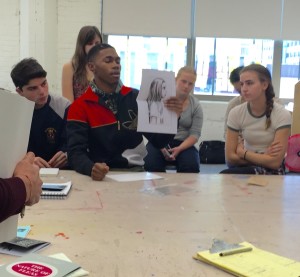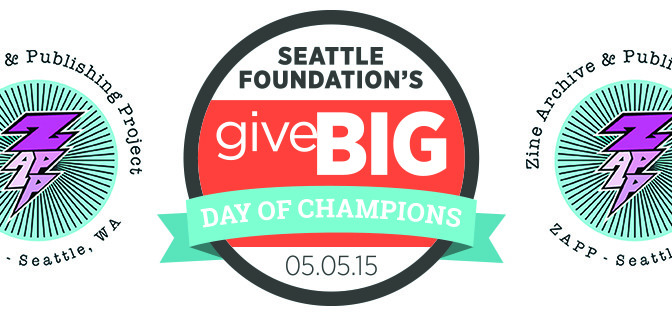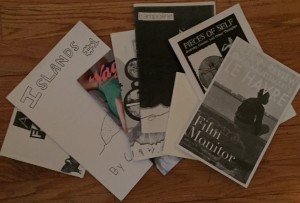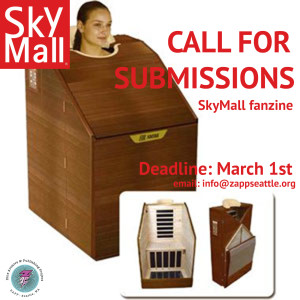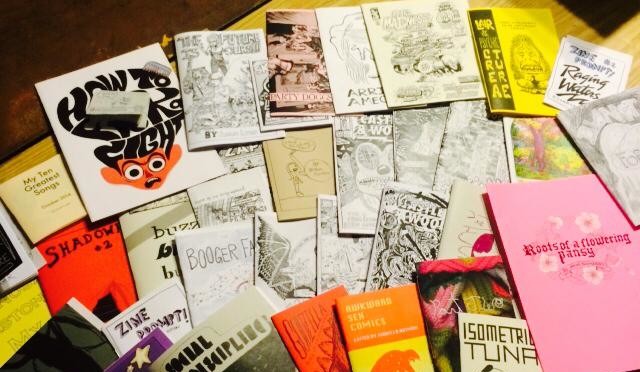By Emma May
Rachel Davies is a freshman at the University of Toronto. She is the founder of Pop Culture Puke, an online platform for young women to share their art. She is also the founder of A Piece of Work Zine Distro, edits a monthly newsletter on zines and popular culture, and founder of a mentor-matching program for young artists from suburban areas. Additionally, she is a regular contributor to publications such as Fixture Mag, The Le Sigh and Broken Pencil.
Introduction to zines
I came into zine making through knowing about Riot Grrrl. Initially, I thought that zines were for exclusively for teen girls. Shortly after, I started Pop Culture Puke and got submissions from the US, the UK and Canada.
When I went to my first zine fair as a tabler I realized that there weren’t a lot of young people making zines, and that most of the people there were adults. I didn’t realize that most zines weren’t made by young people, like the initial impression I got while learning about Riot Grrrl.
Importance of zines in the 21st century
Even though the Internet is a great place to share ideas, I believe that making a zine adds validity to ideas. When I was in high school, I didn’t know a lot of people that shared the same ideas with me. Nonetheless, I had all of these friends online. There was something that cemented our friendships and our ideas in creating a zine together. It’s something that we could bring to school and share, like “look, this is a real thing that I made! I have ideas and other people have these ideas too!”
I think zines are still important because it’s nice to see your work in something that people outside of your social circle and subculture are likely to stumble across. It’s also a more respected form of organizing and idea-sharing than the Internet at this point. You can leave a zine in a public place and someone not affiliated with zine culture can read it. Yet when you’re on Tumblr, within a tight-knit and virtual community, it’s harder to stumble upon new ideas. Communal zines are extremely important. I was able to connect and share ideas with so many people that I wouldn’t have otherwise had the chance to know. It’s a great way to unify people. It’s so much more open now than it has been in the past.
It’s not the Riot Grrrl era anymore. Zines aren’t intrinsically connected to punk. If you are in the suburbs and writing about historically downtrodden ideas, you’re doing something brave. It’s political. You can’t have progress in one kind but then stay still aesthetically. Why are people so mad about the de-popularization of cut-and-paste?
On A Piece of Work Zine Distro
I run A Piece of Work Zine Distro, where I publish art zines, prints, and my own prose zines. We are always taking submissions. I’m not doing any print zines for Pop Culture Puke right now, but I’m still definitely working on that.
I started the distro because I’ve tried to do more independent work. When I was doing Pop Culture Puke, I was too nervous and intimidated to post my own work alone. I felt backed up by having all of these other people. I started the distro because I have been trying to work on having my work alone. It is also a place to publish my friends’ work, who may not be able to publish anywhere else.
On her newsletter and publishing her own work
I made a newsletter where I would interview zine-makers and young artists. I was interested in people making zines and putting their work online, and whether they were doing it because they saw themselves going into a creative field or if they were doing it because it was fun for them. I wanted to get opinions and share the work of people I liked without publishing my own work.
On Suburban Critique Matching Program
I was talking to a friend of mine who’s still in high school and who’s a writer. We were talking about living in the suburbs and how it is so shitty not to have anyone to look your work. So I started the match up program for that purpose. I thought the idea of putting two people who don’t know each other at all would be helpful, and then they can get an unbiased opinion.
On Justin Bieber
It’s frustrating when people view fan-girling as one-dimensional. I’m obsessed with Justin Bieber, there are countless ways to critically think about how he is portrayed and constructed. I’m currently curating a collection of essays about him. He’s been very influential to me. I don’t like him because he’s “cute…” not everything should be centered on stereotypes of my age, gender or sexuality.
On Popular Culture
I grew up in the suburbs and I wasn’t exposed to alternative media. I got my sense of self through pop culture. I was always obsessed with it. When I was a kid, I was always really shy. I got my sense of the world as represented pop culture. In high school, I did school projects like “Representation of Women in Hollywood,” in which I did a 30-minute presentation in from of the class. I talked about the part in Miss Representation when all of the female directors discuss how they constantly get their ideas turned down, and how all-male executives play a part in that. It’s a systemic issue, and it’s super hard to break out of. My teacher, who’s a middle aged white man, responded: “I just feel like it’s tough cookies if men’s stories are the narratives that people want.” It was 20% of my mark. The female characters in movies that are protagonists are usually from books that are best sellers. As a woman, you have to constantly prove yourself in order to be recognized.
How are you going to know if you can achieve things if it’s not represented in the media that you consume in every day life?
Rachel Recommends
I Object
The Chapess Zine
Kendra Yee’s Zines
Troop Collective Zine
Drawing Thinking of You Dancing
Guilty Pleasures in the Age of the Problematic Fave


